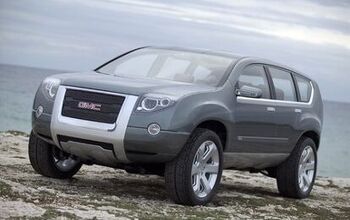General Motors Death Watch 99: It's A Small World
What do China, Thailand, India, Mexico, Eastern Europe and Venezuela have in common? They’re not America. Or, if you prefer, the United Auto Workers don't work there. Which is why General Motors is planning on producing its new Gamma Gamma Hey small car platform in these low-cost labor countries– and exporting the wee beastie to the US and other "developed" nations. In fact, it’s increasingly clear that GM is trying to outsource/globalize/synergize its way out of trouble. It seems to make sense: building standardized products in non-unionized factories will save the carmakers billions. But are they going about it the right way?
On one hand, GM seems to know what it's doing abroad. In China, GM uses its proven engineering and manufacturing skills to create the bird-eyed Buick GL-8 minivan and the recently announced Cadillac STS variant (the SLS). Both vehicles demonstrate The General’s ability to modify established products to local tastes. And there’s no question that GM’s reaping the rewards: sales of Chinese Buicks, Cadillacs, Chevrolets, Opels, Saabs and Wulings rose 35.2 percent this year, to a grand total of 665,390 units.
On the other hand, there’s the Cadillac BLS, a Swedish-built Euro-spec sedan riding on GM’s Epsilon platform, powered by a FIAT-sourced 1.9-liter diesel, wearing a US luxury car badge. Or how about the most recent Pontiac GTO, a re-badged Australian Holden Monaro built on an enlarged Opel Omega B platform (formerly used for the Cadillac Catera), sold in the Middle East as a Chevrolet Lumina SS? The failure of these cars to find a sustainable international audience illustrates the challenge of leveraging economy of scale into a viable product– when you start with economy of scale rather than a viable product.
Of course, GM (and now Ford) aspires to the Toyota model: sell the same "world" car (built on the same platform) in as many markets as possible. That’s fine if A) you build the right car and B) you've got deep enough pockets and a lean enough organization to recover from a major bomb. Do we really believe that GM can pull off a Corolla? The new Gamma platform small car was designed by Daewoo; if past history is any guide, they ain't no Toyota. By the same token, when the Toyota Echo went nowhere fast (in every sense of the phrase), the Japanese automaker re-engineered it to become the best-selling Yaris and other local variants. Does GM have the resources it would need to snatch victory from a dud Gamma-woo?
As Toyota has demonstrated countless times in dozens of countries, “world” cars require a coherent and focused sales, marketing and distribution channel. And that's only possible if the car in question is part of a coherent and focused brand. While analysts tend to think of small cars for developing nations as a commodity– if it's cheap enough, it'll sell– branding plays just as crucial a role at the bottom of the market as it does at the top. A Toyota small car is not an Opel, Daewoo or Chevrolet small car. It's a Toyota, and everyone– designers, engineers, auto workers, marketing execs, dealers, salesmen and customers– know what that means.
What IS GM's world brand these days? Oh right, it has four: Buick, Chevrolet, Cadillac and Saab. Although there are basic distinctions between these brands, things fall apart at the local level. Chevrolets are many brands and a wide variety of models to many people around the world– to the point where GM decided to create a separate "Corvette" brand in Europe. A Cadillac is a luxury car made of unobtanium in some markets, and a garden variety mid-priced mid-sized sedan in others. A Saab is a sophisticated European-style sedan in some markets, and a Chevy Trailblazer with the ignition key between the seats in others.
When it comes to international automobile production, GM’s biggest problem isn’t its cost structure; it’s brand management. No matter where they do business in the world, no matter what food items are on the menu, McDonald’s and its customers know who it is. The same can not be said for GM, which, lest we forget, doesn't even exist as a brand. The General's cluelessness on the product branding front threatens any potential production-related savings from multinational platform sharing. Not to put too fine a point on it, low unit costs only create profits if you sell what you make.
This brings us back to the primacy of products over process, and the all-conquering power of coherent brands. GM CEO Rabid Rick Wagoner may be looking around the world and lovin' it, but until and unless GM sorts out its branding issues, globalization will hasten its destruction, not its success.
More by Robert Farago
Latest Car Reviews
Read moreLatest Product Reviews
Read moreRecent Comments
- Spookiness The Mazda interior really is nice. I recognize the rationale for the Mazda infotainment interface design in lieu of a touch screen, but the filthy masses have spoken. As with the rotary engine, it's time to move on. To sell more cars they'll need to have touchscreens. Other carmakers have evolved beyond the iPad-screwed-on-top-the-dash look, so I'm sure Mazda can come up with something aesthetically pleasing and user-friendly. (Another quibble: I really don't need or want AWD, so I wish it wasn't forced. But again, the masses have spoken.)
- Lou_BC “We are always listening to the customer. "You sayin' the baller/gangsta types don't want Escalades on 24's that don't make vroom vroom rumbly sounds?
- AZFelix I shall fully endorse the use of autonomous cars on public roads once they have successfully completed my proposed Turing test for self driving vehicles. This test requires the successful completion of an at fault incident and accident free 24/7 driving session in Buffalo and upstate New York from October 1st until March 31st, and throughout the city of Jakarta, Indonesia for one consecutive year. Only Level 1 and Level 5 vehicles are permissible.
- Lou_BC I'd go Rav4. No Mazda dealer in my town and from what I've seen, Mazda's tend to rust.
- Steve Jacobs I've got a bright Red Kia EV6. Easy to find in a parking lot.


































Comments
Join the conversation
Quote: # mikey: November 14th, 2006 at 10:52 am Lets put a 90% North American content rule in and see how well Toyota competes with that. I wonder if any TTAC people know how much American content is in that new Tundra built in Texas.If somebody knows post it. A funny thing happened on the way to heaven: At the present, the two vehicles that have the highest NA content wear a Japanese brand: The Toyota Camry and Honda Ridgeline...
[...] We rapidly eat up Robert Farago’s “Death Watch” articles and we were slightly surprised to read a different tone in his one: General Motors Death Watch 99: It’s A Small World. While not positive, it didn’t have the death part down as much as previous ones have had. Is Mr. Farago coming around to think that maybe GM isn’t laying on its deathbed? [...]